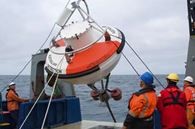Australia joins the world in raising tsunami awareness
04/11/2016

In the lead up to the first World Tsunami Awareness Day on Saturday, 5 November 2016, the Joint Australian Tsunami Warning Centre (JATWC) is reminding Australians what to do if a tsunami warning is issued in their area.
JATWC Co-Director Dr Andrew Tupper from the Bureau of Meteorology said that while Australia had been fortunate to not experience the devastating and deadly consequences of tsunamis such as the 2004 Indian Ocean Tsunami or the 2011 Japan Tsunami, it could be affected in the future.
“Australia is surrounded by 8,000 kilometres of active tectonic plate boundaries capable of generating a tsunami, which could potentially cause significant damage to Australia’s coast line," Dr Tupper said.
"The JATWC, operated by the Bureau and Geoscience Australia 24 hours a day, is the authority for issuing tsunami warnings for Australia and its offshore territories. "Australia has an early detection system that provides instant alerts of earthquakes that could potentially cause tsunamis and includes deep ocean buoys to verify sea level changes caused by a tsunami.
“We estimate that most parts of mainland Australia would receive at least two hours’ notice of an impending tsunami."
JATWC Co-Director Adrienne Moseley said the ongoing partnership between the two organisations was crucial to the continued delivery of accurate and timely tsunami information to Australian communities.
“After Geoscience Australia detects an earthquake, we pass the data onto the Bureau to monitor, assess the threat level and then issue relevant tsunami advice."
So far in 2016, the JATWC has responded to 37 large undersea earthquakes, none of which posed a significant threat to Australia.
Dr Tupper said that while the JATWC’s main role was to provide timely tsunami warning information, it is always looking to raise tsunami awareness and collaborate on innovative approaches to disaster risk reduction.
"Preparation is the key to reducing the impact of a tsunami. This is why Australia is focused on exercising our early warning systems and working with our neighbours in the Indian and Pacific Oceans.”
Since October 2011, the JATWC has been one of the three tsunami service providers for the Indian Ocean, providing threat information to other countries in the region to help them determine the level of threat and what warnings they should issue to their communities.
JATWC also actively participates in international communication tests and tsunami exercises, including the “IOWave16” Indian Ocean wide exercise conducted in September this year.
The UN General Assembly has designated 5 November as World Tsunami Awareness Day in recognition of the “Fire of Inamura” event, when in 1854, a village chief in Japan warned others of a tsunami by setting fire to rice sheaves.
More information
- Further information about how the tsunami warning system works can be found on the Bureau of Meteorology’s Blog: media.bom.gov.au/social/blog
- The JATWC provides updates on tsunami activity at www.bom.gov.au/tsunami or on the Twitter handle @BOM_au
- More information on Geoscience Australia’s work on the science behind tsunamis is available from: ga.gov.au/scientific-topics/hazards/tsunami/australia
QUICK FACTS: TSUNAMI WARNINGS
There are two levels of tsunami warnings:
- Marine Threat Warnings warn of dangerous waves and rips, and strong ocean currents and some localised overflow over the immediate foreshore.
- Land Threat Warnings warn of the major land inundation and flooding to low-lying coastal areas, as well as dangerous waves and rips, and strong ocean currents.
What to do following a tsunami warning:
Marine Threat Warning
- Get out of the water and move away from the immediate water's edge of harbours, coastal estuaries, rock platforms and beaches
- Boats in harbours, estuaries and in shallow coastal water should return to shore. Secure your boat and move away from the waterfront
- Vessels already at sea should stay offshore in deep water until further advised
- DO NOT go to the coast to watch the tsunami
- Check that your neighbours have received this advice
- Keep listening to your local radio station and monitor other media for updates and advice
Land Threat Warning
In addition to Marine Threat advice, if you are in an affected coastal area, you should:
- Go to higher ground, at least ten metres above sea level, or if possible move at least one kilometre away from all beaches and the water's edge of harbours and coastal estuaries
- Take only essential items that you can carry including important papers, family photographs and medical needs
- Consider walking to safety if possible to avoid traffic jams
- If you cannot leave the area take shelter in the upper storey of a sturdy brick or concrete multi-storey building










